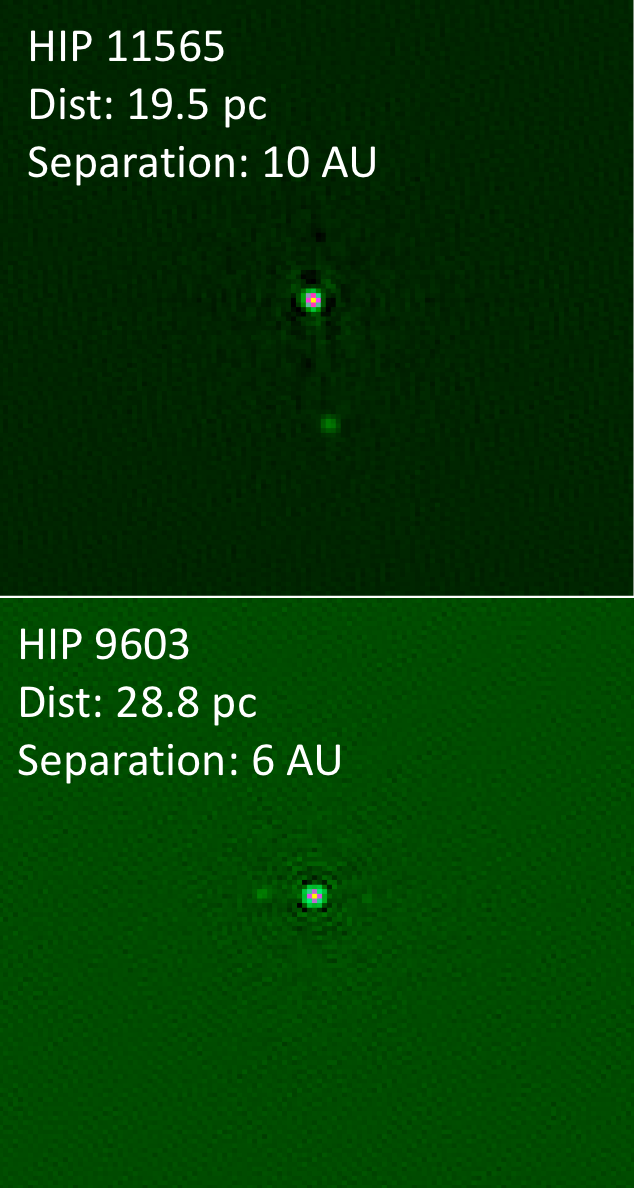Principal Investigator: Prof. Elliott Horch
In speckle imaging, highly magnified images of astronomical objects are recorded at video rates, revealing the dynamic effects of atmospheric turbulence on the light detected. The result is that, while the light is spread out over the image plane, there exist bright points, or speckles, inside the envelope of light that contain diffraction-limited information. From a sequence of such images, it is possible to reconstruct what the image would have looked like if undisturbed by the atmosphere. Depending on the size of the telescope, the final image can be as high as a factor of 50 better in resolution than the limit imposed by the atmospheric blurring.

|
Our speckle work consists of using dual-channel speckle imaging systems, which record speckle patterns in two colors simultaneously. This allows not only for more light to be collected in the same amount of time, but also for information regarding the surface temperatures of the stars to be determined in a single observation. Having two colors also helps us to measure extremely small-separation binary stars by comparing information in both channels. |
Current Projects
|
K-KIDS Survey. Over the last three years, we have collaborated with the RECONS Consortium to use speckle imaging at Lowell Observatory's Discovery Channel Telescope and at both Gemini Telescopes to observe a volume-limited sample of K dwarfs within 50 parsecs of the Sun. The work will provide information on how often these stars form in binary and multiple star systems over a key range in separation — from 1 to about 50 times the Earth-Sun distance. That is, we are studying these systems on a scale similar to that of our own Solar system. In turn, our results will inform theories of star and planet formation, and provide a list of known "single" stars for follow-up work by planet-hunting satellites such as TESS. We are grateful for NSF funding of this project. M Dwarf Multiplicity Survey. Extending the work of the K-KIDS project to fainter stars, this speckle imaging survey seeks to reveal the multiplicity rate for stars of yet smaller mass, the M dwarfs. We work with colleagues at both the RECONS Consortium and Lowell Observatory, using the same telescopes as mentioned above. The goals are also similar: to develop definitive statistics on how often binary and multiple stars form in this mass range. We also gratefully acknowledge NSF funding for this work. |

|
Exoplanet Follow-up Program. In collaboration with the speckle group at NASA-Ames Research Center and others, we are also involved in speckle imaging of exoplanet host stars in support of the K2 an TESS missions. Once a star is thought to host an exoplanet from the analysis of satellite data, we observe and calculate a high-resolution image of the star to see if in addition to its planetary companion, the system also has a small-separation stellar companion. This is important information for determining the correct radius of the exoplanet.
Wide Field Speckle Imaging. The classic speckle imaging analysis is done over a relatively small field of view, typically only about 4x4 arc seconds in size. We are exploring techniques to use speckle techniques over larger fields of view, as large as 1x1 arc minute on the sky. While these techniques do not offer as high a resolution in the final image as with normal speckle observations, significant improvements can be obtained, which enables unique science from the ground, including the study of globular cluster cores and planetary nebulae.
Binary Star Orbits and Stellar Masses. For the last ten years, our group has also observed known binary stars in an attempt to calculate their orbits, and from that, to derive stellar masses. This fundamental work helps to refine one of the key relationships in stellar astrophysics, the Mass-Luminosity Relation of main-sequence stars.
M.S. Theses and Projects
- Frederick W. Hahne, A Determination of M Dwarf Multiplicity Rates Using High Resolution Imaging, M.S. Thesis, 2019
- Nicole M. Granucci, Wide Field Speckle Techniques for the Urban Telescope, M.S. Thesis, 2018.
Recent Papers
E. P. Horch, K. G. Broderick, D. I. Casetti-Dinescu, T. J. Henry, F. C. Fekel, M. W. Muterspaugh, D. W. Willmarth, J. G. Winters, G. T. van Belle, C. A. Clark, and M. E. Everett, "Observations with the Differential Speckle Survey Instrument. X. Preliminary Orbits of K-dwarf Binaries and Other Stars," Astronomical Journal, 161, 295 (2021).
N. M. Granucci and E. P. Horch, "Wide-field speckle techniques for small, urban telescopes," SPIE Proceedings, 10701, Optical and Infrared Interferometry and Imaging VI, 1070110 (2018).
F. W. Hahne, E. P. Horch, G. T. van Belle, C. Clark, J. G. Winters, and T. J. Henry, "Two-color speckle imaging of M-dwarfs with the Discovery Channel telescope," SPIE Proceedings, 10701, Optical and Infrared Interferometry and Imaging VI, 107012A (2018).
N. M. Hess, P. R. Thayer, E. P. Horch, J. W. Davidson, B. J. Baptista, M. E. Everett, and S. B. Howell, "Speckle imaging of KOI binary stars with the WIYN telescope," SPIE Proceedings, 10701, Optical and Infrared Interferometry and Imaging VI, 107012E (2018).
